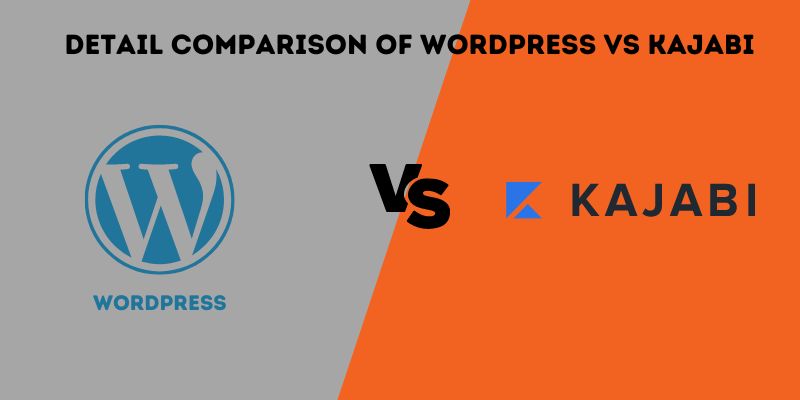
Detail Comparison of WordPress vs Kajabi
You will have some hard decisions to make if you go ahead with website creation. The development of a platform or software for your company website launch, as well as an increase in monetization, is very important. Needless to say, you would have to decide between WordPress vs Kajabi as they are popular and two of the most powerful systems for website development.
While they take similar routes to make their customers happy, the experience offered by WordPress and Kajabi is very different. The Kajabi site provides this, and you also have the option to create your own site. Since Kajabi is loaded with features, you only need to expand on it to start making some cash. The flexibility of Kajabi is lower than that of WordPress, but it is more maintenance-intensive. It is vital to specify the aspects that distinguish the division of alternatives as the way to make the right decision for you.
In the post here, we’ll choose the best among WordPress and Kajabi. Our evaluation will cover why each product is great, what is its unique feature, its price, advantages, and disadvantages, and any other information required. Now let’s get going!
What Is WordPress vs Kajabi?
The Kajabi-hosted platform offers a full spectrum of tools that you can use for course creation and publishing, campaigns of email marketing, payment initiation, community setting up, and many more features.
Stated differently, Kajabi provides almost all of the tools required to develop a profitable website.
Therefore, other platforms also function. It differs from other platforms in that it has everything built into the main platform of the tool and does not require organization through two or more add-on tools.
However, you only need to make a payment once using the Kajabi service provider which caters to hosting as well. The disadvantage is that Kajabi is quite pricey and many developments are subjective to the plan you sign up with.
When someone wants to build a website with WordPress, they practically differ from the first to the last. WordPress, originally built for blogging, is a multi-layered content management system (CMS).
You can download and install the WordPress application on any website server you prefer. Because of the CMS’s extreme flexibility, you can use it to build any kind of website you like:
Because of the CMS’s extreme flexibility, you can use it to build any kind of website you like. What WordPress offers goes beyond what Kajabi promises. However, Kajabi is a one-stop platform. It does not mean that Kajbi is limited to the same use of WordPress. Membership website is also part of this category (b).
The salient distinction is all those features require connector and plugin construction. This difference requires more work, but WordPress can handle almost anything—it seems nearly any constraint can be resolved by someone. What you get in return for the enhanced power you have over the site you create is the fact that it is resource-intensive and can be of great benefit when done carefully.
What Makes WordPress and Kajabi Different
Let’s review each platform’s primary distinctions so that you will understand how it functions better:
- Open-source versus closed-source software. This Kajabi program, however, works in open-source mode. This means that even though the service lets you buy its products, it will not permit you to tap into the source code or violate the limitations set by the platform. WordPress is quite the opposite: it is open source. The CMS provides you with endless capability options to modify to your taste.
- Hosting websites. What comes with no cost is hosting as part of the Kajabi bundle. At your unsureness, the site of the platform is hosted by the servers of the site. Migration will also be hard. You can try any webserver of your choice and can switch to another one if you find it more comfortable.
- Personalization. Although there are many customization possibilities available with Kajabi, they are all integrated into the platform. With WordPress, you have complete control over the CMS and have access to an extensive collection of user-made themes and plugins.
- Revenue Generation. Kajabi offers various options to help you create websites and earn money from them. While WordPress doesn’t have built-in monetization features, you can still add them to the CMS using plugins and integrations.
- Encourage. Since Kajabi is a hosted platform, you may contact direct customer service representatives. If you need help with WordPress, you may contact the plugin and theme developers directly or your web hosting company.
We’ll do that pricing later as the last issue. WordPress implies a budget that can be kept within a limit. The platform is easily available to the user for free, and the hosting is available for $5 a month. Moreover, lots of highly-rated plugins and themes are available for free, whereas the average amount you will pay a year for the premium ones runs from $50 to $100.
Whether we like it or not, the same stands true regarding Kajabi. The basic Kajabi program costs $149 per month, and you will likely need to pay this expense upfront. Meanwhile, for the next part, our pricing discussion is here.
WordPress vs Kajabi
The subsequent sections will compare the different features of WordPress and Kajabi. I will explain what defines WordPress and what Kajabi is built to achieve. Each one has its own pros and cons besides the issue of SEO, pricing, and web design.
Benefits & Limits of Kajabi
These are the key advantages and disadvantages of utilizing Kajabi.
Benefits of Kajabi
- It’s incredibly easy to use.
- Without requiring any third-party integrations, you have access to all the capabilities required to build, promote, and make money from a website.
- The system supports various use cases, including blogs, podcasts, online academies, community and membership websites, and more.
- Since it’s an all-in-one solution, web hosting is not a concern.
- It has integrated payment capabilities.
In basic terms, Kajabi provides a straightforward one-stop shop for building and maintaining a variety of website kinds.
Limits of Kajabi
- Given that Kajabi is a costly platform, all of that functionality comes at a cost.
- Each plan restricts the quantity of goods you can publish. This is true for both online goods and other components like classes. Using Kajabi to manage a business might be challenging because of this, as it only provides three plans.
If you have multiple shops with a wide variety of goods, you have to take out the costliest plan from Kajabi to operate your e-commerce site. We may still have inadequate numbers even with 100 products the Pro plan supports. For large e-commerce websites, it does not suffice, though.
Benefits & Limits of WordPress
WordPress can rival, if not surpass, Kajabi in terms of capabilities. On the other hand, the CMS provides a completely distinct user experience. Here are the particular benefits and drawbacks that result from it.
Benefits of WordPress
- Since the platform is open-source, you are free to use it any way you see fit.
- With thousands of plugins at your disposal, you may equip your website with about any feature you can think of.
- Most well-known services have integrations for it because it’s the most widely used CMS worldwide.
- You may alter the look and feel of your website by selecting from hundreds of themes.
- You can host your website anywhere you like.
As you can see, the CMS’s primary selling point is its limitless potential. You really may pick your own trip in this way.
Limits of WordPress
- In comparison to Kajabi, its out-of-the-box features are far more limited. To fully utilize Kajabi’s capabilities and build an all-inclusive solution, you’ll need to locate the appropriate plugins and connectors.
- The configuration procedure might take some time if you wish to build a complicated website.
All-in-all, WordPress has some advanced features one can put to use to fashion a website unrivaled in its customizability. But it comes with a price: tools selection and handling the CMS lining up of ins and outs are some of the obstacles you face.
WordPress vs Kajabi: Creating Your Website
While we have made the discussion of creating websites using Kajabi rather than WordPress WordPress website development, the methodology has many disparities. Each of these solutions, although they belong to different approaches, is based on the fact that the first one uses drag-and-drop website builders, and the second one uses templates or themes built in WordPress. Now we will discuss each of these processes in much more detail.
Utilizing Kajabi to Build Your Website
Kajabi provides extensive support throughout the full website launch process when you join up. The platform initially inquires as to what sort of website you want assistance creating:
It could also pose more queries. For instance, if you’re creating a coaching website, Kajabi inquires as to whether you want to coach students one-on-one or in groups, as well as the number of sessions you anticipate offering:
Whether you are picking what content the site will have or setting up the site’s overall setting, it all starts with configuring the site. Switching between the Kajabi interface is very easy as the has all the functionalities that you will need while using the system.
Once you select Website from the tabs menu, which is the starting point in Kajabi, you will be presented with the option to choose a template. This will be the default layout for your website, which you may alter later. This will be the basic template/ layout for your site, and you have the option of changing it later.
Kajabi will give you templates for your site depending on the kind of site you are building. Modern designs are included in every template, but they do not offer as many possibilities as one might hope for.
You may alter a template once you’ve chosen it:
You can accomplish this using the visual editor by simply adding, rearranging, or changing the ready-made modules on the page.
Using WordPress to Build Your Website
Doing it yourself with WordPress for a web project will deprive you of some resources. The console will enable you to track the daily progress after the setup of the WordPress web is accomplished. Next, you can proceed either trying to commence the site’s development or changing the theme.
The selection procedure, which is a word equivalent to this Kajabi template called WordPress theme, happens to be choosing the free and paid alternatives. The following free options are visible if you browse to the dashboard’s accessible themes:

The already existing Block Editor of WordPress enables you to make a new set of pages and content without caring about what theme you are using. Pre-built elements are available in the editor for you to arrange, modify, and add to a page:
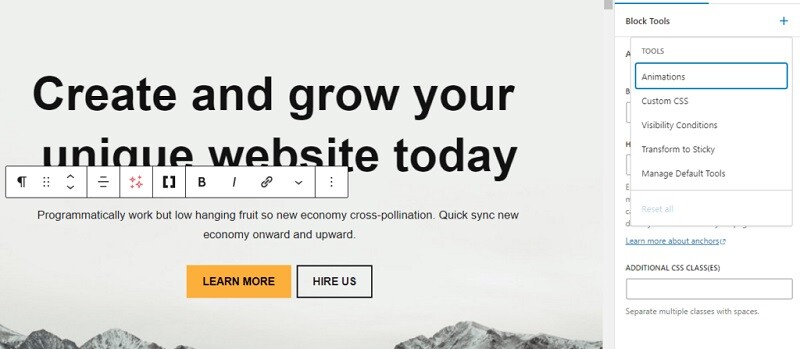
Hence, if we think over the things mentioned, you will have much more website customization opportunities set by WordPress. You can do virtually anything with a theme’s design, including pages, colors, background images, headers, footers, and fonts.
Also, it is crucial to note that most plugins provide instructions for setting them up, which some users might have missed. Specifically, the WooCommerce setup wizard simplifies the creation of e-commerce websites, as it was designed to make it easy for people to use.
Search Engine Optimization Kajabi vs WordPress
You may use a simple set of Search Engine Optimization (SEO) tools with Kajabi. This allows you to customize each post or page’s title, meta description, and tags:
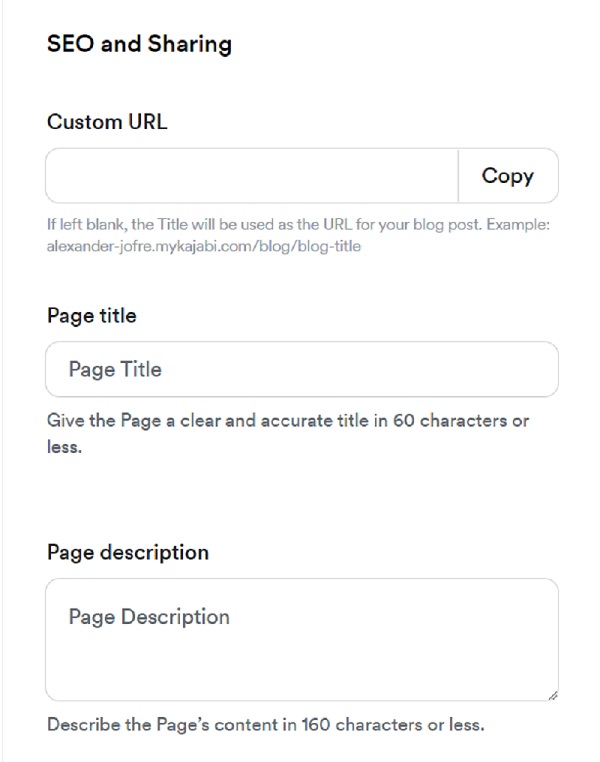
From an SEO point of view, this is the highest we can go. The page ranking may not only depend on the SEO settings of the platform; rivalry and repetitive use of appropriate keywords can significantly affect ranking too.
By default, SEO tools do not come with WordPress regardless of the built-in features. Peanut butter tastes delicious, but many websites like to use free SEO plugins, Yoast SEO for their search engines.
With the help of these instruments, you can give a meta description and a title phrase for the search engines as well as perform a range of essential SEO functions. They frequently go one step further and provide you the option to customize how your material shows up on social media.
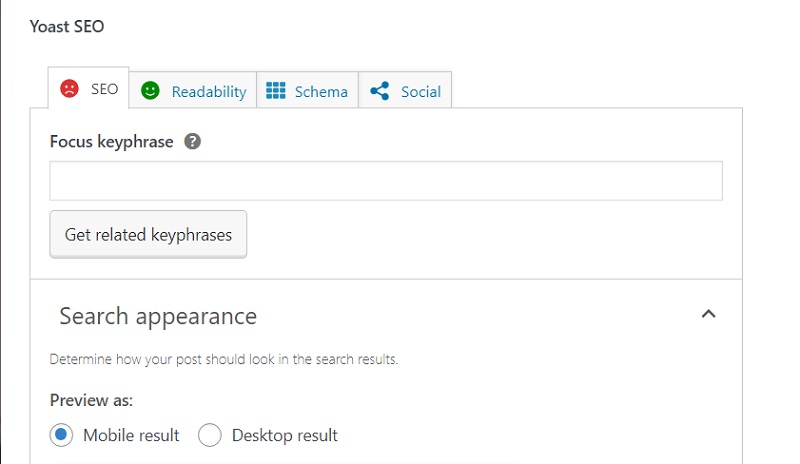
Similarly, the majority of WordPress SEO plugins offer explicit advice on SEO best practices. Usually, they accomplish this by giving you “scores” for every article or page that indicate how well you adhere to fundamental on-page SEO guidelines.
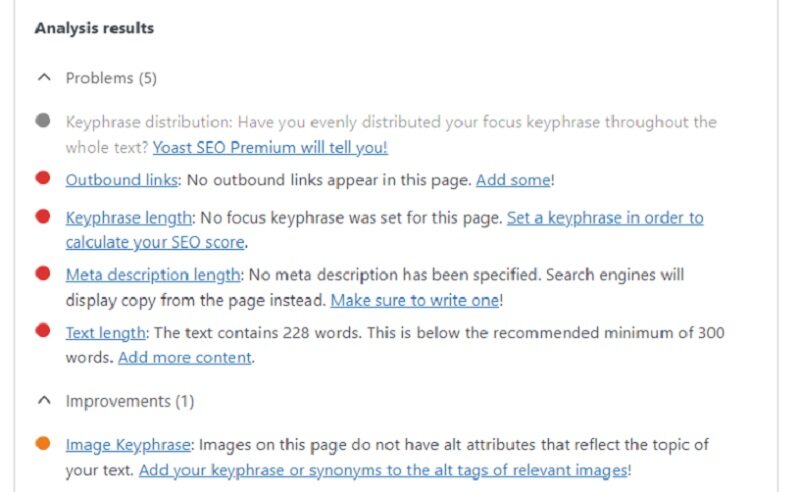
This method might be quite beneficial if you don’t know the fundamentals of SEO. While high SEO plugin ratings aren’t always in higher ranks, they do offer helpful advice.
WordPress vs Kajabi: Building LMSs and Course Websites
The Learning Management System (LMS) support of Kajabi, which is one of its most notable features, helps schools manage classroom content and assess students effectively and efficiently. This implies that you are capable of doing the course sales on the internet with Kajabi, too. Moreover, you will be in control of your offerings without the demand for third-party integrations.
Once granted permission to access the Kajabi dashboard, you can always add classes to it. Besides requesting basic course information such as names and descriptions, the platform includes built-in AI capabilities to assist in creating outlines.
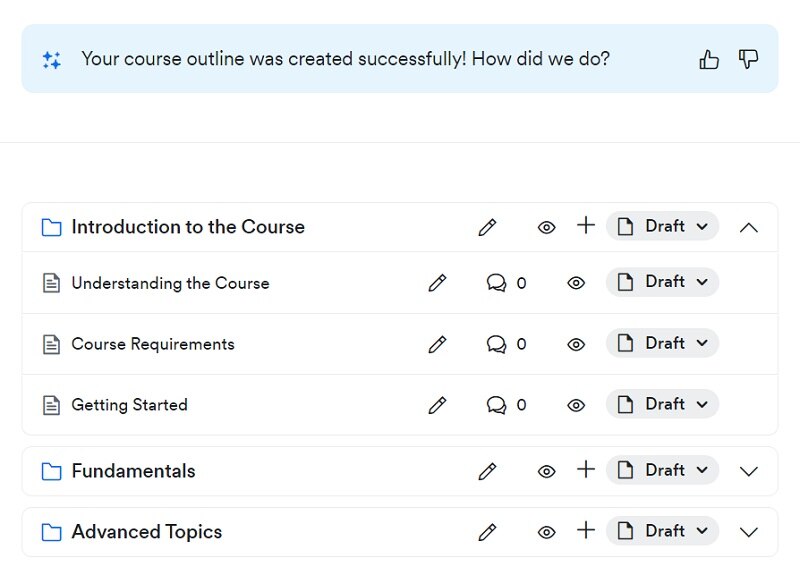
Creating pages in Kajabi is not the same as customizing courses. You’ll use a simple editor to add text, video, and audio files to each course in place of the platform’s page builder:

The major feature is not the course content but the numerous other supplementary utilities, such as automation, which can make up for the lack of a higher-end, more intelligent course builder. Instantly, you can make Kajabi’s automatic functions available to users. Those include giving access to course number two after finishing the first one.
On the other hand, we’ll examine how WordPress lacks LMS functions. The Curriculum Management System is large in size, so upgrading the system is necessary to install plugins and develop online courses.
Using it could extend the time needed to prepare a course or module at the beginning. Now that you’re in control, you can make clever choices about the plugins you prefer.
It’s also important to keep in mind that Kajabi has plan-based limitations on the quantity of items you may publish, including courses. While WordPress LMS plugins usually don’t have any restrictions of this kind, the basic Kajabi subscription only allows for the support of up to three goods or courses.
Kajabi vs WordPress A Comparison of Prices
Pricing-wise, comparing Kajabi with WordPress is a bit more difficult. With monthly rates beginning at $149, Kajabi appears to be the more costly platform at first sight.
For instance, one of the most compelling reasons is that hosting one website will be equal to hosting another. Aside from most of the capabilities we have discussed now, this package will enable active customers to hit the highest mark up to 1000.
In costly versions of Kajabi, in addition to more features and support for extra products, you can get access to more support staff as well. Furthermore, you are provided with the services of automation, affiliate marketing, and the possibility to remove the Kajabi branding.
To remove the Kajabi logo from your website, you must pay at least $199 per month. Therefore, Kajabi is best suited for users seeking a pricier solution than other options in the market. It’s important to note that even if you save 20% off your package every year, you still lose $100.
WordPress differs in that it does not bind you to a certain platform. Anywhere may host your website, and some services start at just $5 a month.
You could wish to spend money on certain premium plugins and themes in addition to hosting. These are also usually reasonably priced.
If you don’t need many premium features or highly reliable hosting, WordPress is usually cheaper. You can build a WordPress site with the same capabilities as any Kajabi plan for a fraction of the cost. However, cheaper doesn’t always mean better. WordPress is great if you want complete control over your site. But if you prefer a platform that handles most maintenance and doesn’t require much effort to add features, Kajabi might be worth the extra cost for the time it saves, especially for a simple website.
Integrations Kajabi vs WordPress
To unpack integrations, Kajabi vs WordPress operates on different levels. When you tap into Kajabi, you access a platform designed with various features for purposes ranging from website building to monetization.
Thus, a few integrations can be used. Overall, Kajabi provides over 15 integrations, with a concentration on well-known services like PayPal, Stripe, and Google Tag Manager: Overall, Kajabi provides over 15 integrations, with a concentration on well-known services like PayPal, Stripe, and Google Tag Manager:
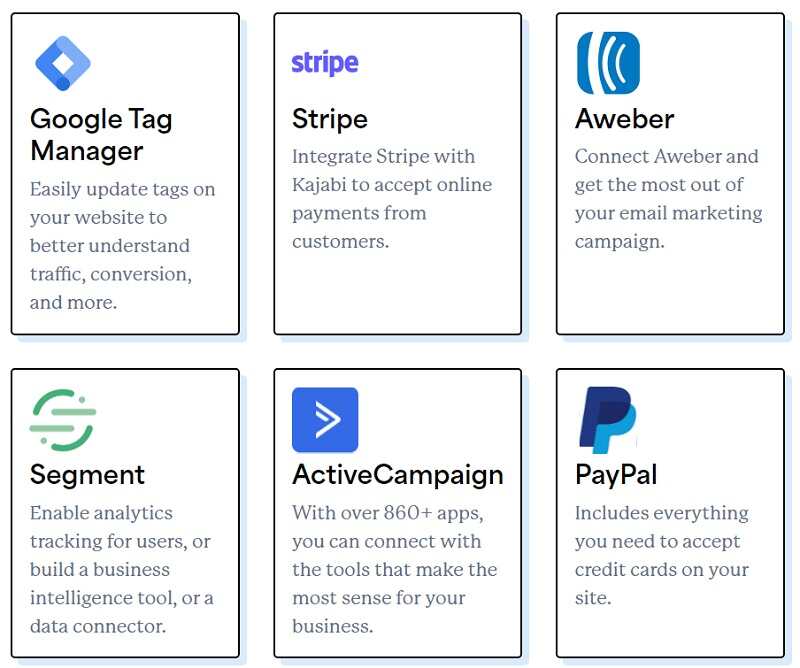
The vast majority of integrations allow for features that Kajabi already has, that is, internally. Normally, these are for cases when you, personally, prefer to use an outside provider to manage one aspect or various parts of the system.
WordPress dominates website integration, offering compatibility with numerous third-party services and specialized website functionalities. This is largely due to its extensive support network, making it the world’s most widely used content management system.
The WordPress plugins repository features more than just a collection of plugins to choose from, though. Those third-party service providers that we regularly use mostly provide compatibility plugins.

That is, but a tiny portion of the alternatives are accessible. WordPress is the undisputed champion for platforms that provide you with the most integration options.
WordPress vs Kajabi for Payment Collection
Thus, with Kajabi, even life is simple: you will get everything on board, including the money collection feature. You may accept credit card payments, Afterpay, Google Pay, and Apple Pay on your website by utilizing Kajabi Payments. We include this Meta in all plans and integrate it into Kajabi. Besides, Kajabi charges 0 percent of the transaction fee, which is an unusual case among payment solutions providers.
Subscription management and refunds and the issuing of receipts are all the processes Kajabi helps with, together with, debtors’ payments coinage, and cash change records. On the other hand, the program offers dispute management services, such as problems of merchants that are frequently charged back.
However, the absence of built-in payment capabilities in WordPress still remains a standing point. Plugin installation through which payments are supported directly will be your necessary duty, and in case a payment processor through a third party is available, such service will be helpful too.
A multitude of plugins in the WordPress Plugins section cater to the checkout process. Core plugins such as WooCommerce and MemberMouse not only facilitate payments but also manage memberships.
Choosing the right third-party processor or plugin is crucial for your WordPress site’s payment processing. While there are many alternatives to Kajabi, their compatibility may vary, potentially making the setup process more challenging.
WordPress vs Kajabi: Which Is Better for Your Company?
This Kajabi vs. WordPress comparison has now gone over all the information you require to choose between these two systems wisely. Let’s summarize which choice is preferable for specific use situations to aid in your decision-making:
- Kajabi If you’re looking for a monetization-focused all-in-one platform, using Kajabi makes sense. This service is primarily intended to assist you in starting an internet company. However, if you want to offer a huge library of items, it’s not the ideal choice for e-commerce.
- WordPress of the two, this is by far the most adaptable choice. WordPress allows you to create any type of website or online store. In the long term, CMS can be far more affordable and scalable than Kajabi, but it involves more work to set up and modify.
Kajabi limits the number of products that can be published to 100, making it unsuitable for websites focused on selling products. For smaller sites with fewer items, it might suffice, but for a robust e-commerce solution, consider using WooCommerce with MemberMouse.
Considering everything, Kajabi is a great choice for an all-in-one platform to create and monetize a website, from initial setup to promotion. While it may be pricey, if the cost fits your budget, it’s unlikely you’ll regret investing in it.
The second option, which allows more customization, is WordPress. This CMS is interesting for those who seek full control over the website and company’s operations. You can add pretty much any feature and any integration to it and make sure every part of your site is customized for cheaper than if you were to use Kajabi, but it will take much more time.
Conclusion
Final Thoughts: WordPress vs Kajabi provides two different but important resources for content creation and management. Both platforms offer exceptional versatility and user-friendliness, but Kajabi’s main capabilities and intended use cases make it a perfect solution for online businesses rather than just websites. Which of the two is the right one for them will largely depend on their own particular requirements and preferences.
Some of these include technical skills needed, level of theme customization, and even, to some extent, your marketing agenda. There is no universal Web 2.0 site that is perfect for everyone, so the choice is entirely up to you, but remember that it is only useful if you employ its functions to achieve your internet goals.